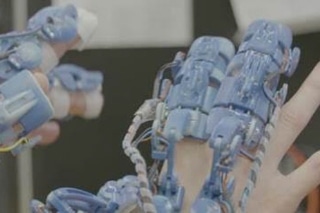Mar 15 2017
 (Credit: http://www.bristol.ac.uk/)
(Credit: http://www.bristol.ac.uk/)
A research team has collaborated to develop an advanced wearable robotic system for minimally invasive surgery, also called keyhole surgery. This latest breakthrough will not only provide surgeons with dexterous and natural movement, but will also allow them to ‘see’, ‘sense’, control, and safely find the way through the surgical environment.
The European Commission has funded the €4 million research project as part of HORIZON 2020 scheme.
The study will be headed by Professor Sanja Dogramadzi from the Bristol Robotics Laboratory (BRL) and UWE Bristol, with nine partners including Bristol Urological Institute, North Bristol NHS Trust, and the Translational Biomedical Research Centre (TBRC) at the University of Bristol, headed by Director, Professor Raimondo Ascione. Also involved in the project is Professor Chris Melhuish, Director of BRL.
For some clinical applications, minimally invasive surgery is replacing the standard 'open access' approach and has been shown to provide several benefits to patients, including fewer infections, reduced blood loss, and faster recovery. If advanced robotic systems are developed with precision, integrated better vision, and ergonomic systems, they can possibly substitute laparoscopic tools for keyhole surgery in a number of clinical areas.
According to the pan-EU research team and Professor Dogramadzi, better tools are needed in robot-assisted minimally invasive surgery to support and improve the surgeon’s performance in orthopaedic, cardiovascular, and urology fields and also to extend the technology’s potential to more complicated surgical procedures.
As part of the project, the research team will create advanced biomedical systems based on clinical feedback. These tools will imitate complex senses and dexterity of the humans and can be easily worn by surgeons. They will then transmit the surgeon's own movements to the closed surgical interface without any limitations, thus reducing the overall manipulation, cognitive, and training demand.
The new surgical robotic system will be initially developed with three important pieces of hardware. Exoskeletons fitted over the surgeon's hands will control the instruments within the body – a new surgical 'gripper' that imitates the hand’s thumb and two fingers.
The instrument will be inserted in the body and will have haptic abilities, which will enable the surgeon to ‘feel’ the organs and tissues inside the body, just like they do during traditional surgery. Scientists at Bristol Robotics Laboratory - Dr Antonia Tzemanaki and her supervisory team Professors Pipe, Dogramadzi, and Melhuish – developed the new prototype.
The exoskeleton worn on the surgeon’s hand will allow a more intuitive movement and also give the surgeon a sense of touch. This system will have a dual sense of touch: Current research in haptic systems primarily focuses on the user’s arm/forearm. In this project, the system will also focus on haptic feedback on the surgeon’s fingers.
The research team will also develop smart glasses that will provide the surgeon with a realistic view of what is occurring inside the body while using the sophisticated robotic tools developed. In fact, with the smart glasses, surgeons can position themselves anywhere in the operating theatre.
In our project the exoskeleton will record the position of the fingers and communicate this to the robotic tools inside the body using tele-operated technology. We want to give existing processes a more natural interface - operating surgeons will not have to do any unusual or unnatural movement. They will be able to use their hands as they would in open incision surgery. This also means that training to use the robotic technology for surgery will be quicker. The other part of our system will be smart multifunctional glasses, which will relay live images from inside the body. This is an advance compared to current systems, which use a flat TV-like screen to relay images back to the surgeon. The research will use the expertise and feedback of senior surgeons to develop the tools. We will use rapid prototyping to make prototype tools that the surgeons will be able to test and we will incorporate their feedback into the next stage of design. This means we can adapt tools to the needs of different surgical procedures and this user-centred design process places surgeons at the heart of the development of this system. We hope our research into designing this wearable system will help to expand the range of surgical procedures that can use robotic assisted systems so that more patients and hospitals can gain the benefits from this type of surgery.
Professor Sanja Dogramadzi from the Bristol Robotics Laboratory
Professor Raimondo Ascione, Director of TBRC and Professor of Cardiac Surgery and Translational Research in the Faculty of Health Sciences at the University of Bristol, and Mr Anthony Koupparis, Consultant Urologist of Bristol Urological Institute, (North Bristol NHS Trust) will provide contextual feedback in the cardiovascular and urology, respectively that is key for developing new sophisticated tools.
Professor Ascione said: "The advent of effective biomedical technologies makes this exciting collaborative project within reach. We will be delighted to test the new prototype at the state of the art national TBRC preclinical facility operating at NHS and GLPMA standards."
Mr Koupparis added: "This research will allow an important step in the future with potential to help many more patients across UK and EU, while reducing the cost burden on healthcare systems."
BRL is collaborative partnership between the University of the West of England (UWE Bristol) and the University of Bristol.